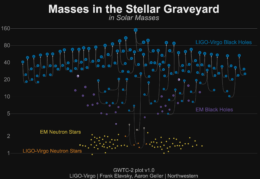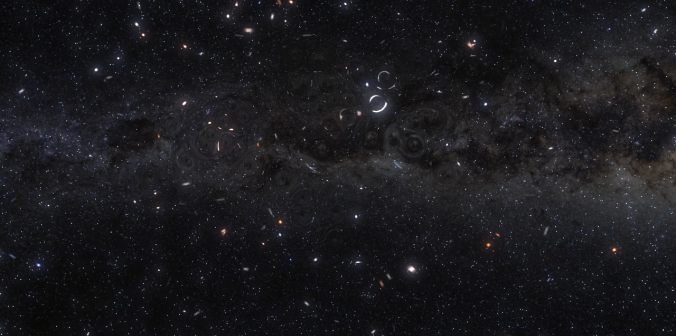Since the first merger of two black holes detected in 2015, the LIGO/Virgo gravitational-wave detectors have observed a total of 47 confident collisions of black holes and neutron stars through the end of September 2019. What’s the big picture behind these events? The second gravitational-wave catalog is officially out — and the population statistics are in!
A New Catalog
In recent years, the Advanced LIGO detectors in Hanford, WA and Livingston, LA and the Advanced Virgo detector in Europe have kept a watchful vigil for ripples in spacetime that let us know that a pair of compact objects — black holes or neutron stars — has spiraled in and merged.

The rapidly expanding “stellar graveyard”, a plot that shows the masses of the different components of observed compact binary mergers included in the second gravitational-wave transient catalog (GWTC–2). [LIGO-Virgo/Northwestern U./Frank Elavsky & Aaron Geller]
In a new publication recently accepted to Physical Review X, the collaboration has released its second catalog of gravitational-wave events (GWTC–2), which includes data from O1, O2, and O3a. And in a companion publication in the Astrophysical Journal Letters, the team has now analyzed the broader set of all 47 mergers in the catalog, using population models to gain deeper insight into the binary properties and how these systems form and evolve.
Learning About Collisions
So what have we learned from the GWTC–2 population?
- Black-hole mass is more complicated than we originally thought.
The merging black holes in O1 and O2 all had primary masses below 45 solar masses, consistent with the theory that black holes of ~50–120 solar masses shouldn’t be able to form. But O3a included several primaries above 45 solar masses, so we can’t model the primary mass distribution as a single power law with a sharp cutoff at 45 solar masses anymore. This may suggest that we’re looking at different populations of black holes that formed in different ways. - Some black holes have spins that are misaligned with the angular momentum of the binary.
Nine of the recent detections exhibit misaligned spins, which is another clue about their formation. Black hole binaries that form and evolve in isolated pairs are expected to have aligned spins, whereas black hole binaries that form dynamically — due, for instance, to interactions in clusters of stars or in the disk of an active galactic nucleus — should have isotropically distributed spins. The authors show that the spinning GWTC–2 population is consistent with 25–93% of black holes forming dynamically. That’s a large range, but what’s important is that this also indicates there’s more than one formation channel at work! - The black hole merger rate probably increases with redshift.
Updated estimates suggest that binary black holes merge at a rate of 15–38 Gpc–3 yr-1 and binary neutron stars at a rate of 80–810 Gpc-3 yr-1. The merger rate appears to be higher at higher redshift, but this increase doesn’t quite parallel the known increase in star formation rate with redshift. An intriguing mystery!
A Smashing Good Time Ahead
These takeaways clearly represent a dramatic increase in our understanding of how and where black hole binaries form and evolve — but we still have so much left to learn! Luckily, there’s plenty more data ahead: the collaboration is now analyzing the remaining 5 months of data from O3, and the detectors are currently undergoing upgrades in preparation for O4, which is slated to begin in mid-2022.
Citation
“Population Properties of Compact Objects from the Second LIGO–Virgo Gravitational-Wave Transient Catalog,” R. Abbott et al 2021 ApJL 913 L7. doi:10.3847/2041-8213/abe949



4 Comments
Pingback: Nowe spostrzeżenia LIGO/Virgo na temat łączących się czarnych dziur – PTMA Kraków
Pingback: Nowe spostrzeżenia LIGO/Virgo na temat łączących się czarnych dziur – Astronomia Śląska
Pingback: From AAS NOVA : “New Insights from LIGO/Virgo’s Merging Black Holes” | sciencesprings
Pingback: Tweede catalogus van zwaartekrachtgolven leert ons meer over samensmeltende zwarte gaten